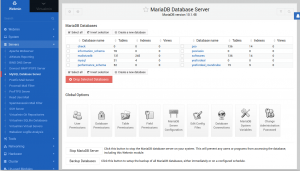

The Records file field controls where the configuration file containing the zone's records is stored.Webmin will automatically convert this to the in-addr.arpa format for you when the domain is created. For a reverse zone, just enter the network address like 192.168.1. In the Domain name / Network field, enter the name of the zone without any trailing dot.However, if it is a reverse zone for looking up hostnames from IP addresses, set the field to Reverse. If this is to be a forward zone like or, leave the Zone type field set to Forward.This will take you to the page shown in the image below for entering the details of the new zone. On the module's main page, click on the Create a new master zone link below the table of existing zones.However, you cannot normally register it yourself until your DNS server has been set up to host it. If this is going to be Internet domain that will be visible to other everyone in the world, the domain name must not have been registered by anyone else yet. Decide on a name for the new zone, such as or internal.If you want to add a new master zone to your server's configuration, the steps to follow are: A single zone may be hosted by multiple servers, but only one is the master - all the rest are slaves. Instead, click on the Module Config link and check that all the paths are correct for your system.īind DNS Server Main Page Creating a new master zoneĪ master zone is one for which your DNS server is the authoritative source of information. If you are certain that your BIND configuration is valid and that the DNS server is already running, do not click the Create button, as your nf file will be overwritten. This form is only shown if Webmin detects that the configuration file nf does not exist, or if the zone files directory that is specifies is non-existent. If you have never set up BIND on your system, when you enter the module for the first time the main page will display a form for setting up the DNS server, as shown below. This can be useful for creating zones that are only visible to systems on an internal network, even if your DNS server is connected to the Internet. Normally all clients see the same zones, but with BIND 9 you can restrict the visibility of some domains to only particular clients, identified by their IP addresses. A view is a set of zones that are visible to only some DNS clients. The most important one that is supported by this Webmin module is views. Versions 9 of BIND has some features that version 8 does not. However, very few systems have this kind of dynamic updating activated. This means that if you are running some other program that dynamically updates zones by communicating with BIND (such as a DHCP server), then this module should not be used as it may interfere with these changes.

This Webmin module always updates all of these files directly, instead of by communicating with the running BIND process. The records in each zone are stored in separate files, usually found in the /var/named directory. īIND's primary configuration file is /etc/nf, which contains all of the zones that the server hosts, and global configuration settings that apply to all zones.
WEBMIN CHANGE PORT DOWNLOAD
If the module cannot find the DNS server, an error message will be displayed on the main page - if this happens, check your operating system CD or website for a BIND package, or download and compile the source from.
WEBMIN CHANGE PORT INSTALL
Most versions of Unix and Linux include BIND 8 or 9 as a standard package, so it is rarely necessary to install it. The older version 4 has a different configuration file format, and can be configured using the BIND 4 DNS Server module, documented in a later section of this chapter.īecause BIND is available for almost all Unix systems and works identically regardless of operating system, the instructions in this chapter apply not just to Linux but to other versions of Unix as well. The BIND DNS Server module (found under the Servers category) supports the configuration of versions 8 and 9. Several versions have been released over the years, the most recent being version 9.


 0 kommentar(er)
0 kommentar(er)
